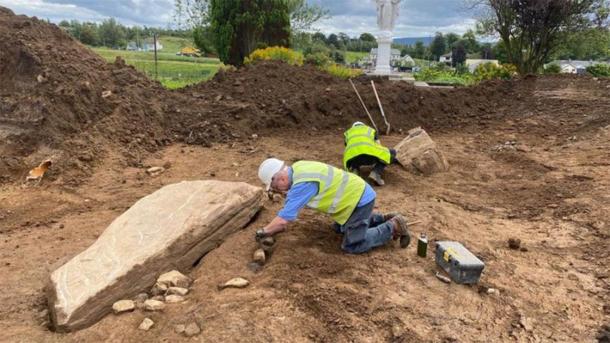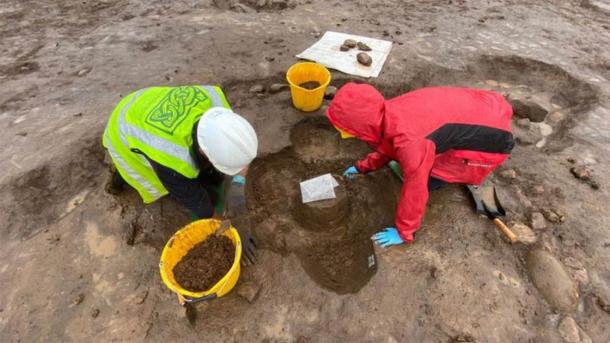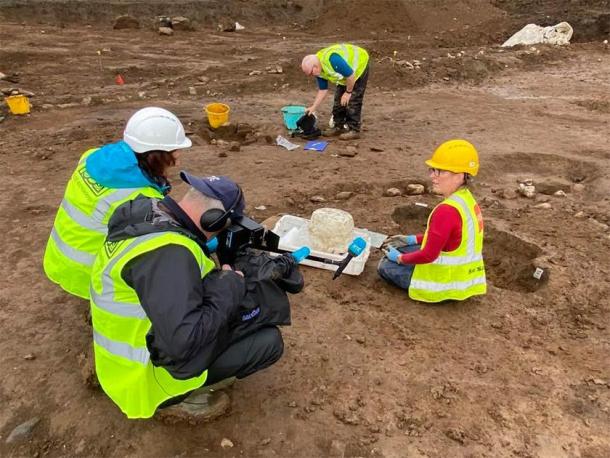Archaeologists have unearthed a rare Bronze Age burial urn in Ireland. The urn dates back 4000 years and was found in a community garden allotment used by locals. This find is latest discovery at what appears to be an important ancient burial site. The Bronze Age burial urn was found during an investigation before the planned construction of a new community hospital in Ballyshannon in northwest Ireland. The archaeological project was led by Tamlyn McHugh of Fadó Archaeology. During the investigations, a capstone or flat megalithic boulder was also found, which once formed part of an ancient burial site that dates to the Bronze Age. Together, these finds are helping scientists to understand the development of Bronze age funerary practices and beliefs.
The New Burial Urn Classed As A Boulder Burial
There was some rock art carved on the capstone, in the form of small engraved circles . The Leitrim Observer reports that “Monuments of this kind are classified as Boulder Burials and are thought to date to the Bronze Age 2500 BC to 500BC.” Boulder Burials are a type of Mid-Late Bronze Age megalithic monument. So far, they have only been found in Ireland, almost exclusively in the counties of Cork and Kerry. They consist of a fairly large boulder set atop three or four much smaller supporting stones. No human remains were found under the capstone.

One area of the Irish burial site during the excavation process. Note the large megalithic stone on the left. ( Fadó Archaeology )
Three archaeologists were involved in the investigations. The work was later extended to some allotments where local people grow vegetables and flowers. It was here that the Bronze Age burial urn was unearthed in a circular ditch , which may be the remains of a palisade. It is a type known as an inverted urn burial, meaning the urn is placed in the ground upside down. Tamlyn McHugh told the BBC that “It’s really nice to find, it seems to be in pretty good condition and it’s actually upturned, so it’s an inverted urn.”
Removing A Buried, Up-Side-Down Urn Isn’t Easy!
The Leitrim Observer reports that “Urn burials date to the Bronze Age and comprise a large ceramic pot usually highly decorated, and containing cremated remains.” It appears to have been highly decorated which is typical of the era. The urn was set in the earth and clay and it was feared it would break if it was removed and this posed a problem.
To solve the urn retrieval process, archaeologists called on Susannah Kelly, a specially trained archaeological conservator. Susannah has removed similar urns from the soil in the past. And she came up with an ingenious way to remove the object, safely. The conservator wrapped the urn in cling film and wrapped it in special resin bandages and took it out of the ground in one block. This procedure was likened to a “mini-excavation,” reports the BBC. The conservator managed to successfully remove the urn.

How the Bronze Age burial urn was found in the ground, upside down. ( Fadó Archaeology )
Despite all her experience, Susannah was very excited and she told RTE that “this was because you are the first person to see it in 4000 years.” The intact urn was taken to Dublin where the conservator will preserve it. Some material, believed to be human remains, was found at the burial site. An osteoarchaeologist will examine these remains to find out more about the individual or individuals remains found in the cremation urn.

Susannah Kelly (on the right), a specially trained archaeological conservator, showing RTE reporters the successful removal of the urn from the earth and clay it was surrounded by. ( Fadó Archaeology )
Bronze Age Burial Changes: From Group To Individual Burials
The discovery of the Bronze Age burial urn, and other artifacts found at the site, are regarded as major finds. Tamlyn McHugh said it highlights the benefits of archaeologists working on sites before development, according to RTE. Ms McHugh stated there is evidence “in Ballyshannon of three different types of Bronze Age burials,” as reported by the BBC.
Apart from the urn and the boulder burial, a dozen other burial pits have also been excavated. These finds are from an era when individual burials became more common than communal burials. This appears to indicate a major shift in Bronze Age religion and society .
Artifacts And Testing Will Yield Further Bronze Age Insights
Organic remains found at the site will be carbon dated and this will reveal more about the sequence of the burials. This is important according to Ms McHugh so that archaeologists can “get an idea of which burial practices came before the other,” reports the BBC. This could help them to better understand the evolution of Bronze age funerary practices and beliefs.
Once the site has been excavated, the area will be returned to local people. They will once again use it for their vegetables and flowers. There are discussions about commemorating the Bronze Age finds in some way in the area.
Top image: The Bronze Age burial urn about to be removed from where it was found, a tricky process! Source: Fadó Archaeology
By Ed Whelan
Related posts:
Views: 0
 RSS Feed
RSS Feed

















 September 9th, 2020
September 9th, 2020  Awake Goy
Awake Goy  Posted in
Posted in  Tags:
Tags: 
















